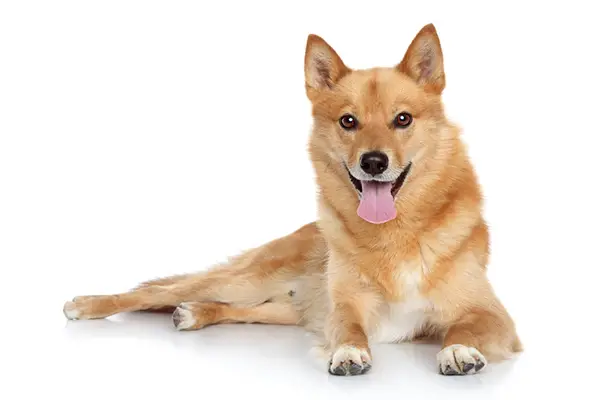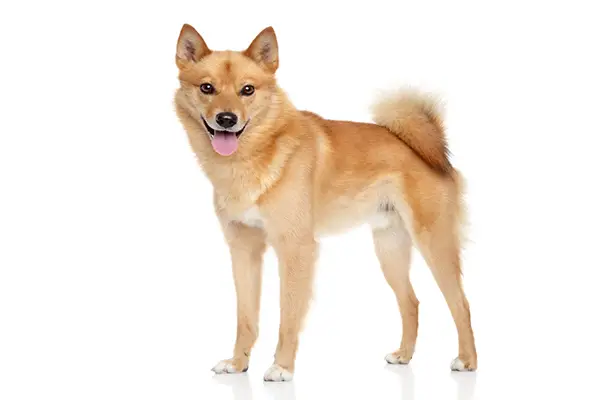The Finnish Spitz is a medium-sized dog with a height less than 20 inches. These dogs have fox-like features, ears that stand upright, tails curled at the back, and wear a lively expression. Their sturdy bodies are covered with a dense coat that is a bit thick around the neck and comes in golden-red or honey colors.
If you’re looking for an excellent watchdog with strong vocals, this is the dog to get. They love their families, and they can be overly protective. Provide them with a home filled with love, and they’ll surely return this with an equal amount of affection and loyalty.

Finnish Spitz Statistics
| Dog Breed Group | Non-Sporting |
| Breed Size | Medium |
| Height | 17.5-20 inches (male); 15.5-18 inches (female) |
| Weight | 25-33 pounds (male); 20-28 pounds (female) |
| Lifespan | 13-15 years |
Finnish Spitz Breed Ratings
| Energy level | |
| Exercise needs | |
| Requires attention | |
| Playfulness | |
| Trainability | |
| Shedding | |
| Grooming | |
| Friendly with family | |
| Friendly with kids | |
| Friendly with strangers | |
| Friendly with other dogs | |
| Prey Drive |
Finnish Spitz History
The origin of Finnish Spitzes is unknown. It’s believed that they were brought to Finland from central Russia by migrating tribes thousands of years ago. These dogs were then used for hunting food, particularly birds.
For years, Finnish Spitzes remained untouched in the country, until transportation and roadways improved by the 18th century. People brought dogs to Finland and started crossing their dogs with the Finnish Spitz. The cross-breeding went overboard and the breed almost went extinct.
Fortunately, two huntsmen saw some Finnish Spitzes while they were hunting in the northern forests, and immediately, a thought came that they needed to save the breed. They then spent decades selectively breeding dogs to achieve the modern look of the breed.
One of the two men, Hugo Sandberg, wrote a very descriptive article about the dogs in 1892 that the Finnish Kennel Club finally recognized the breed. A breed standard was written after, based on the article he wrote. By 1897, the breed was named Finnish Spitz.
For 30 years, the other man, Hugo Roos, dedicated most of his time to preserving the breed. The favor was immediately returned as he is credited with building the foundation of the dogs.
However, as the breed’s number increased and became popular in England, World War II came. Breeding of the dogs was still continued, but the qualities are not as great. Importation then began in many areas in England, and by 1959, Finnish Spitzes were first imported to the US.
The dogs were recognized by the American Kennel Club in 1988 and currently ranks 184th in popularity in the US. But, in their native land, Finland and Sweden, they are a well-established breed.
Finnish Spitz Temperament
Finnish Spitzes are friendly, good-natured, and lively dogs. They are active and love playing hard. This is what makes them excellent companions for active owners who also love the outdoors.
You need to give these dogs enough exercise to keep him entertained. A bored Finnish Spitz can be destructive, so always find ways where you can stimulate their minds and bodies.
These dogs love people, and they most especially love spending time with their families. They thrive for human companionship, especially with their favorite person. As they can be very sensitive, they must not be left alone for long periods.
They also love children and get along quickly with other animals raised with them. But they can be conservative when it comes to strangers, and bold with strange dogs, particularly those of the same gender.
With their sharp-eye and a keen sense of hearing, they make excellent watchdogs. alert you when something seems off. One thing that makes them stand out from other breeds is their loud bark.
Early socialization is very important for Finnish Spitzes, so they become more well-rounded. Training should be given at the same time, but you should be ready to take on the challenge. These are clever and independent dogs. You must be consistent and firm, so he follows what you say.

Finnish Spitz Care Requirements
- Nutrition: Finnish Spitzes don’t have any special dietary requirements as long as it is high-quality and balanced with the essential nutrients they need for growth – proteins, fats, and carbohydrates. You can buy lots of high-quality ingredients that contain these nutrients. We recommend animal meat for protein, fish oils for fats, and whole grains for carbohydrates. You can add a mix of vegetables and fruits, too, for sources of fiber and vitamins. For dog food, choose ones that are of premium quality. It shouldn’t contain fillers, additives, and by-products which all have low nutritional value. You should also have a list of ingredients your dog is allergic to and make sure to stay away from those. If there’s one thing to take note with the Finnish Spitzes, it’s that they are prone to obesity. You need to watch the number of calories you feed them in a day so they remain healthy. Ask your vet for food requirements specific to what your dog needs.
- Grooming: Finnish Spitzes have medium-length coats that shed seasonally. The coat is very easy to maintain, which most owners describe as wash-and-wear type. It needs weekly brushing to remove debris and loose hair and prevent mats and tangles from forming. It’s highly advised not to trim the dog’s coats, except for the feet area. Baths can be given occasionally depending on how much your dog needs it, but ears should be cleaned regularly. Nails should be trimmed weekly or once every two weeks, so it stays short.
- Exercise: Finnish Spitzes are hunting dogs and they have incredible stamina. They are highly energetic and would require lots of activities to stay fit, healthy, and happy. These dogs are happiest when doing activities with their owners or families. Play sessions and long walks on a leash is a great way to keep them healthy. They are best paired with people who love the outdoors, too, and can cope with his impressive energy and endurance.
- Health: Finnish Spitzes are generally healthy with a long lifespan. However, he is still susceptible to a few common dog diseases, and you must be aware of what those are. For these dogs, there are three conditions you’d need to watch out for:
- Canine Hip Dysplasia
- Patellar Luxation
- Epilepsy
- There might also be more hereditary diseases that they might acquire, so meeting at least one of your dog’s parents would be a great idea. Screening tests should also be done to detect certain conditions early. As dog owners, closely monitoring your dog’s behavior is important. If you notice any changes, take him immediately to the vet for treatment.
- Lifespan: The life expectancy of Finnish Spitzes is 13-15 years.
Famous Finnish Spitzes
- Mountjay Peter, Kiho Seivi, and Friedstahills Sala: Finnish Spitzes imported to England to improve the breed’s quality after the World War
- Tophunter Tommi and Tophunter Turre: One of the top-winning Finnish Spitzes until the early 1970s
- Penan Pipsa: All-time top brood bitch of the Finnish Spitz in England
Fun Facts about Finnish Spitzes
- Finnish Spitzes are ancient dogs with a long history in Scandinavia.
- They almost went extinct by the year 1880 due to outcrossing.
- They are the National Dog of Finland.
- They are called Suomenpystykorva in Finland.
- They are called by other names – Finsk Spets, Spitz Finnico, Spitz Finlandes, Finse Spitz, Finnen Spitz.
- They were used for all-around hunting.
- They are descendants of the Taimyr Wolf.
- Finnish Spitzes are all born with black coats.
- They were fully recognized by the American Kennel Club in 1988.
Check Out Other Non-Sporting Dog Breeds:
American Eskimo Dog, Bichons Frises, Boston Terrier, Bulldog, Chinese Shar-Pei, Chow Chow, Coton de Tulear, Dalmatian, Keeshonden, Lhasa Apsos, Lowchen, Norwegian Lundehund, Schipperkes, Shiba Inu, Tibetan Spaniel, Tibetan Terrier, Xoloitzcuintli
